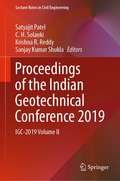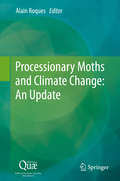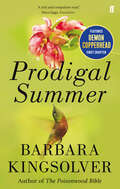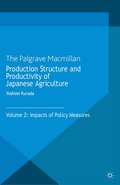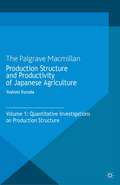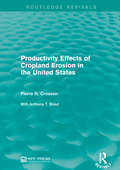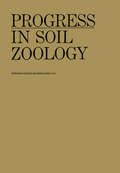- Table View
- List View
Proceedings of the Indian Geotechnical Conference 2019: IGC-2019 Volume II (Lecture Notes in Civil Engineering #134)
by Satyajit Patel C. H. Solanki Krishna R. Reddy Sanjay Kumar ShuklaThis book comprises select proceedings of the annual conference of the Indian Geotechnical Society. The conference brings together research and case histories on various aspects of geotechnical and geoenvironmental engineering. The book presents papers on geotechnical applications and case histories, covering topics such as (i) Characterization of Geomaterials and Physical Modelling; (ii) Foundations and Deep Excavations; (iii) Soil Stabilization and Ground Improvement; (iv) Geoenvironmental Engineering and Waste Material Utilization; (v) Soil Dynamics and Earthquake Geotechnical Engineering; (vi) Earth Retaining Structures, Dams and Embankments; (vii) Slope Stability and Landslides; (viii) Transportation Geotechnics; (ix) Geosynthetics Applications; (x) Computational, Analytical and Numerical Modelling; (xi) Rock Engineering, Tunnelling and Underground Constructions; (xii) Forensic Geotechnical Engineering and Case Studies; and (xiii) Others Topics: Behaviour of Unsaturated Soils, Offshore and Marine Geotechnics, Remote Sensing and GIS, Field Investigations, Instrumentation and Monitoring, Retrofitting of Geotechnical Structures, Reliability in Geotechnical Engineering, Geotechnical Education, Codes and Standards, and other relevant topics. The contents of this book are of interest to researchers and practicing engineers alike.
Processes, Assessment and Remediation of Contaminated Sediments (SERDP ESTCP Environmental Remediation Technology #6)
by Danny D. ReibleThe purpose of this book is to help engineers and scientists better understand contaminated sediment sites and identify and design remedial approaches that are more efficient and effective. Contaminated sediment management is a difficult and costly exercise that is rarely addressed with easily identified and implemented remedies. It is hoped that this book can help identify and implement management approaches that provide an optimal, if not entirely satisfactory, solution to sediment contaminant problems.
Processes of Vegetation Change
by C.J. BurrowsThis book is about ideas on the nature and causes of temporal change in the species composition of vegetation. In particular it examines the diverse processes of inter action of plants with their environment, and with one another, through which the species composition of vegetation becomes established. The first chapter considers the general nature of vegetation and the ways in which vegetation change is perceived by ecologists. Chapters 2 and 3 provide essential background about the relationships between plants and their abiotic and biotic environment. Anyone who is familiar with the fundamentals of plant ecology may prefer to pass over Chapters 2 and 3 which, of necessity, cover their subject matter very briefly. Sequences of development of vegetation on new volcanic rocks, sand dunes and glacial deposits, respectively, are outlined in Chapters 4, 5 and 6. Chapter 7 is about the patterns of vegetation change which occur in severe habitats around the world, and Chapter 8 discusses wetlands. Chapter 9 discusses the diverse responses of temperate forests to a variety of disturbing influences, and Chapter 10 deals with change in the species-rich forests of the Tropics. Chapter 11 treats, in detail, the empirical and inferential data on the biological processes occurring during vegetation change sequences. Chapter 12 considers the plant community phenomena which are implicated in the development of theory about vegetation change. The final chapter, Chapter 13, draws the diverse themes together into a unified theoretical structure by which the vegetation change phenomena may be understood.
Processionary Moths and Climate Change: An Update
by Alain RoquesBecause of its peculiar biology, its negative impacts on forestry, and its urticating larvae affecting human and animal health, pine processionary moth has largely been studied in many European countries during the last century. However, knowledge remained scattered and no synthesis has ever been published. Since the IPCC retained the moth as one of the two insect indicators of climate change because of its expansion with warming up, filling this gap became increasingly important. Led by INRA, this book associates 101 authors from 22 countries of Europe, Minor Asia and North Africa, combining all the concerned research fields (entomology, ecology, genetics, mathematical modelling, medical and veterinary science, pest management) in a multidisciplinary approach to understand and model the processes underlying past, present and future moth expansion and to propose adapted management methods. Besides, the major biological patterns of the related processionary species are also detailed.
Prodigal Summer: A Novel
by Barbara KingsolverIt is summer in the Appalachian mountains and love, desire and attraction are in the air. From her outpost in an isolated mountain cabin, Deanna Wolfe, a reclusive wildlife biologist, watches a den of coyotes. She is caught off guard by a young hunter who invades her most private spaces and interrupts her solitary life. On a farm several miles down the mountain, Lusa Maluf Landowski, a bookish city girl turned farmer's wife, finds herself marooned in a strange place where she must declare or lose her attachment to the land that has become her own. And a few more miles down the road, a pair of elderly feuding neighbours tend their respective farms and wrangle about God, pesticides, and the possibilities of a future neither of them expected. Over the course of one humid summer, these characters find their connections of love to one another and to the surrounding nature with which they share a place. With its strong balance of narrative and drama, Prodigal Summer is stands alongside The Poisonwood Bible and The Lacuna as one of Barbara Kingsolver's finest works.
Product Stewardship: Life Cycle Analysis and the Environment
by Kathleen SellersConsider the Consequences of Bringing a Chemical to MarketProduct Stewardship: Life Cycle Analysis and the Environment explores the regulatory and scientific aspects of the life-cycle consequences of bringing a chemical to market. Using case studies to bring critical points to life, this multidisciplinary text explores the factors that influence ou
Product Stewardship: Life Cycle Analysis and the Environment
by Kathleen SellersConsider the Consequences of Bringing a Chemical to MarketProduct Stewardship: Life Cycle Analysis and the Environment explores the regulatory and scientific aspects of the life-cycle consequences of bringing a chemical to market. Using case studies to bring critical points to life, this multidisciplinary text explores the factors that influence ou
Production, Growth, and the Environment: An Economic Approach
by William L. WeberWritten in a way that facilitates understanding of complex concepts, laws, and policy, Production, Growth, and the Environment: An Economic Approach explores how economic growth usually makes people better off, but also asks at what environmental cost? These costs are not often realized until after the fact, when their remediation is more expensive
Production of Biofuels and Chemicals with Ionic Liquids (Biofuels and Biorefineries #1)
by Zhen Fang Richard L. Smith Xinhua QiThe application of ionic liquids to biomass for producing biofuels and chemicals will be one of the hot research areas during the next decade due to the fascinating properties of these versatile group of solvents that allow them to dissolve lignocellulosic materials. The present text provides up-to-date fundamentals, state-of-the-art reviews, current assessments and prospects in this area, including aspects of pretreatment, fermentation, biomass dissolution, cellulose transformation, reaction kinetics and physical properties, as well as the subsequent production of biofuels and platform chemicals such as sugars, aldehydes and acids. Auxiliary methods such as catalysis, microwave and enzymatic techniques used in the transformations are covered. Both researchers and practitioners are certain to find a wealth of information in the individual chapters, which were written by experts in the field to provide an essential basis for assessing possible pretreatment and transformation routes of biomass using ionic liquids, and for developing new methods and chemical processes. Dr. Zhen Fang is Professor of Bioenergy, head of the Chinese Academy of Sciences’ Biomass Group, Xishuangbanna Tropical Botanical Garden and is also an Adjunct Professor of Life Sciences, University of Science and Technology of China. Dr. Richard L Smith, Jr. is Professor of Chemical Engineering at the Graduate School of Environmental Studies, Research Center of Supercritical Fluid Technology, Tohoku University, Japan. Dr. Xinhua Qi is Professor of Environmental Science at Nankai University, China.
Production of Ethanol from Sugarcane in Brazil: From State Intervention to a Free Market (Natural Resource Management and Policy #43)
by Márcia Azanha Ferraz Dias de Moraes David ZilbermanThe success of Brazil in the large-scale production and use of fuel ethanol has been widely discussed and analyzed by other countries interested in adopting policies designed to encourage the use of biofuels. Within this context, certain questions arise: Could the Brazilian experience be replicated in other countries? What were the conditions that enabled the creation of the Brazilian Proálcool (National Ethanol Program and what lessons can be learned? To examine these issues, it is important to understand the functioning of the key, interconnected markets (those for sugarcane, sugar and ethanol), which, from their inception, were the objects of extensive government intervention until 1999. Two main conditions enabled the creation of Proálcool: robust production of sugarcane and sugar (tightly regulated by the government, which applied the numerous regulations then in place); and the military regime that was in place at the time, whose decision-making and enforcement powers were quite broad, facilitating the carrying out of the necessary actions, as well as making it easier to coordinate the activities of the various stakeholders and sectors involved. This book increases understanding of the functioning of the sugarcane supply chain in Brazil, not only during the phase of government intervention but also in recent years (in the free-market environment). The lessons, positive and negative, gleaned from the Brazilian experience can contribute to reflection on and the development of alternative modalities of biofuel production in other countries, making the book of interest to scholars and policy-makers concerned with biofuel and renewable resources as well as economic development.
Production Structure and Productivity of Japanese Agriculture: Volume 2: Impacts of Policy Measures
by Y. KurodaAnalyzes quantitatively in a comprehensive, consistent, and integrated manner the production structure and productivity of postwar Japanese agriculture for the latter half of the 20th century, more specifically, 1957-97.
Production Structure and Productivity of Japanese Agriculture: Volume 1: Quantitative Investigations on Production Structure
by Y. KurodaAnalyses quantitatively in a comprehensive, consistent, and integrated manner the production structure and productivity of post-war Japanese agriculture for the latter half of the twentieth century, more specifically, 1957-97.
Production, Use, and Sustainability of Groundwater: Groundwater Economics, Volume 1
by Charles A. JobGroundwater is becoming increasingly scarce while the demand for water continues to grow at a global scale. Understanding groundwater resources and their sustainable management is imperative for the future of groundwater use, conservation and protection. This revised and updated two-volume set, focused on sustainability, covers the economic values of groundwater production and use, including micro- and macroeconomic factors, groundwater markets, economic evaluation tools, climate change, transboundary issues and policy evaluation. It explores numerous applications and describes ways to evaluate the economics of groundwater use in the context of the larger ecosystem and the natural capital it provides. FEATURES OF THIS VOLUME Includes an important new chapter on groundwater sustainability management Addresses new examples of groundwater use that are applicable at both the local and international levels Provides the foundation for policy, program and project analysis for all major uses of groundwater Updates groundwater use data along with explanations of major production costs and use benefits Gives a new perspective on users’ competition for the subsurface environment Production, Use, and Sustainability of Groundwater, Second Edition, the first volume of the two-volume set Groundwater Economics, is a must-have for any professional or student who needs to understand, evaluate and manage water resources from a range of production and use perspectives affecting groundwater resource sustainability.
Production, Use, and Sustainability of Groundwater: Groundwater Economics, Volume 1
by Charles A. JobGroundwater is becoming increasingly scarce while the demand for water continues to grow at a global scale. Understanding groundwater resources and their sustainable management is imperative for the future of groundwater use, conservation and protection. This revised and updated two-volume set, focused on sustainability, covers the economic values of groundwater production and use, including micro- and macroeconomic factors, groundwater markets, economic evaluation tools, climate change, transboundary issues and policy evaluation. It explores numerous applications and describes ways to evaluate the economics of groundwater use in the context of the larger ecosystem and the natural capital it provides. FEATURES OF THIS VOLUME Includes an important new chapter on groundwater sustainability management Addresses new examples of groundwater use that are applicable at both the local and international levels Provides the foundation for policy, program and project analysis for all major uses of groundwater Updates groundwater use data along with explanations of major production costs and use benefits Gives a new perspective on users’ competition for the subsurface environment Production, Use, and Sustainability of Groundwater, Second Edition, the first volume of the two-volume set Groundwater Economics, is a must-have for any professional or student who needs to understand, evaluate and manage water resources from a range of production and use perspectives affecting groundwater resource sustainability.
Productivity Effects of Cropland Erosion in the United States (Routledge Revivals)
by Pierre R. CrossonIn the 1970’s, agriculture in the United States seemed to be booming. With an extra demand for crops, extra acres were taken on to increase production which was predicted to increase further with an ever-growing population. However, concerns were beginning to be raised over the adequacy of land for crops as potential croplands began to be converted into urban areas as well as the effects of soil erosion decreasing the quality of these croplands. Originally published in 1983, this study investigates the threats to crop productivity in the U.S. with a focus on human-made problems. This title will be of interest to students of environmental studies.
Productivity Effects of Cropland Erosion in the United States (Routledge Revivals)
by Pierre R. CrossonIn the 1970’s, agriculture in the United States seemed to be booming. With an extra demand for crops, extra acres were taken on to increase production which was predicted to increase further with an ever-growing population. However, concerns were beginning to be raised over the adequacy of land for crops as potential croplands began to be converted into urban areas as well as the effects of soil erosion decreasing the quality of these croplands. Originally published in 1983, this study investigates the threats to crop productivity in the U.S. with a focus on human-made problems. This title will be of interest to students of environmental studies.
The Professional Practice of Environmental Management (Springer Series on Environmental Management)
by Robert S. DorneyThis series is dedicated to serving the growing community of scholars and practitioners concerned with the principles and applications of environ mental management. Each volume is a thorough treatment of a specific topic of importance for proper management practices. A fundamental ob jective of these books is to help the reader discern and implement man's stewardship of our environment and the world's renewable resources. For we must strive to understand the relationship between man and nature, act to bring harmony to it, and nurture an environment that is both stable and productive. These objectives have often eluded us because the pursuit of other in dividual and societal goals has diverted us from a course of living in balance with the environment. At times, therefore, the environmental manager may have to exert restrictive control, which is usually best applied to man, not nature. Attempts to alter or harness nature have often failed or backfired, as exemplified by the results of imprudent use of herbicides, fertilizers, water, and other agents. Each book in this series will shed light on the fundamental and applied aspects of environmental management. It is hoped that each will help solve a practical and serious environmental problem.
Progress in Botany 77 (Progress in Botany #77)
by Ulrich Lüttge Francisco M. Cánovas Rainer MatyssekWith one volume each year, this series keeps scientists and advanced students informed of the latest developments and results in all areas of the plant sciences. The present volume includes reviews on plant genetics, physiology, ecology, and evolution.
Progress in Marine Conservation in Europe: NATURA 2000 Sites in German Offshore Waters
by Henning Nordheim Dieter Boedeker Jochen C. KrauseThis volume offers insight in the identification and selection procedure of marine protected areas in the German exclusive economic zones (EEZs) of the North - and Baltic Seas. EU Member States are obliged to establish a coherent network of protected areas, consisting of sites identified under the EC Habitats and Birds Directives. The goal of this Natura 2000 network is the conservation of biodiversity on land and in the sea. To fill important gaps in knowledge regarding the presence, abundance, and distribution of certain species and habitats in the German North- and Baltic Seas, the German Federal Agency for Nature Conservation (BfN) initiated a detailed research programme, involving researchers from many renowned German marine research institutes. This book contains the main results of the different projects under this research programme, which formed the basis for the identification and selection of the Natura 2000 sites. Information is given on two NATURA 2000 habitats (sandbanks and reefs), and benthic species, fish, birds and marine mammals, as well as on legal aspects and implementation procedures. Last but not least the book introduces the current status of NATURA 2000 in the German EEZ. Target audience are not only scientists, but also policymakers, environmental organisations and other stakeholders, and the book includes many illustrations.
Progress in Nitrogen Cycling Studies: Proceedings of the 8th Nitrogen Workshop held at the University of Ghent, 5–8 September, 1994 (Developments in Plant and Soil Sciences #68)
by O. Van Cleemput G. Hofman A. VermoesenThis book contains the proceedings of the `8th Nitrogen Workshop' which was held at the University of Ghent, Belgium, from 5 to 8 September 1994. Although nitrogen dynamics in different ecosystems have been studied for several decades, new orientations and other emphases have recently emerged. Previously, nitrogen was considered as an essential element mostly in terms of productivity, but now, more emphasis is attached to environmental consequences. More than 100 contributions in this book tackle recent developments within the fields of nitrogen advice systems, plant response to fertilization, immobilization and mobilization, nitrification, denitrification, leaching, ammonia volatilization and biological nitrogen fixation. A large number of papers is devoted to the formation of gaseous nitrogen compounds, while mineralization-immobilization is another topic of important interest. The book also contains the reports of discussion groups on different aspects of the nitrogen cycle.
Progress in Plant Nutrition: Food security and sustainability of agro-ecosystems through basic and applied research (Developments in Plant and Soil Sciences #98)
by N. Wirén M. K. Schenk U. Schmidhalter B. Sattelmacher V. Römheld H. W. Olfs W. Merbach H. Goldbach W. B. Frommer H. Flessa N. Claassen A. Bürkert Walter J. HorstThese papers include two lectures which address the role of Plant Nutrition in the sustainability of agro-ecosystems and the production of enough high quality food to feed the growing world population. Recent advances in Plant Nutrition are reviewed in the 11 papers presented in each of the Symposia devoted to: genetics and molecular biology of Plant Nutrition, nutrient functions, the role of the apoplast in mineral nutrition, plant quality and plant health, salinity and plant-soil-water relations, mineral element toxicity and resistance nutrient acquisition, soil organisms/plant interactions, fertiliser use in relation to optimum yield and environment, nutrient dynamics in natural and agro-ecosystems, and plant nutrition and sustainable development. Current knowledge and research emphasis in these areas of the subject is well illustrated and the reader is provided with a comprehensive view of the state of Plant Nutrition research.
Progress in Soil Zoology: Proceedings of the 5th International Colloquium on Soil Zoology Held in Prague September 17–22, 1973 (Transactions of the Prague Conferences on Information Theory)
by J. VanekLadies a n d g e n t 1 e m e n , I have the pleasure to welcome you here in Prague in the name of the Czechoslovak Academy of Sciences and to open the Fifth Inter national Colloquium on Soil Zoology. We are very glad that Czecho slovakia was chosen for this important meeting. It is clear to all of us that the soil plays and will play a de cisive part in providing food for the explosive increase of human pop ulation. For this reason we watch with great anxiety the negative influence of human activities on the environment accompanied also by the other destructive intervention into the soil ecosystem, its devas tation by inefficient management, application of herbicides and pesti cides pollution by the waste products of industry and human settlements. The basis for solving these accumulating and now sometimes latent prob lems is among others a good knowledge of the role of soil organisms in the cycles of materials and in the energy flow. Soil zoology as a part of soil biology is still at the beginning of this trend The lack of in formation about life in soil is obvious when compared with the results of a related biological science dealing with the water ecosystem.
Progressive Development: To Mitigate the Negative Impact of Global Warming on the Semi-arid Regions (Environmental Science and Engineering)
by Arie S. IssarThe book is based on the results of the investigations of the authors in the semi-arid and arid regions (ASAR) of the globe. These investigations brought to the conclusion that the warming climate will cause the drying up of the water resources in these regions. In this case the principles of Sustainable Development will not be able to avert forthcoming catastrophes. These conclusions brought to the compilation of the policy of "Progressive Development", emphasising investment in the development of new water resources and changing the natural environments while advancing the local populations on the dimension of knowledge by education.
Project Management: A Practical Approach (Routledge-Noordhoff International Editions)
by Roel GritProject Management introduces students in a unique and accessible way to projectbased working as a means to tackle projects successfully. Not only in business circles, but also in the field of education, increasingly more activities are performed using a projectbased approach. Consider for example comprehensive study assignments, internal projects and projects during work placement and the fi nal stages of a degree. The line of approach of this book is practiceoriented. Based on assignments, groups of two to three students work on a project plan and an executive summary. Students can also opt for a ‘real’ assignment for a company or for one of the cases of the accompanying website. Added to this fifth edition are examples and illustrations, new sections about various subjects and a chapter about the flexible project approach Scrum.
Project Management for Environmental, Construction and Manufacturing Engineers: A Manual for Putting Theory into Practice
by Nolberto MunierAs a companion to books on project-management theory, this book illustrates, in a down-to-earth, comprehensive style, how to put that theory into practice. In addition to the many examples that illustrate procedures, the book includes over 25 case studies, each one addressing a specific theme. Key topics, such as project selection, negotiations, planning and scheduling, cost and budgeting, project control, human resources, environmental impacts, risk management, and financial evaluation, are discussed, using a step-by-step approach. Beginning at the grassroots level, some cases are solved by hand to illustrate the mechanics of a procedure, while others are solved using advanced computer programs. In this way the reader has a clear idea of the problem, how and when to raise the issue, information needed (and who can provide it), how to solve it by hand, when possible, and also its resolution using the latest informatics tools.
